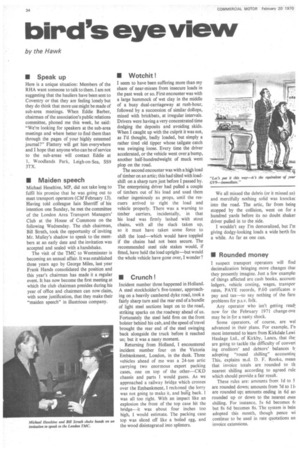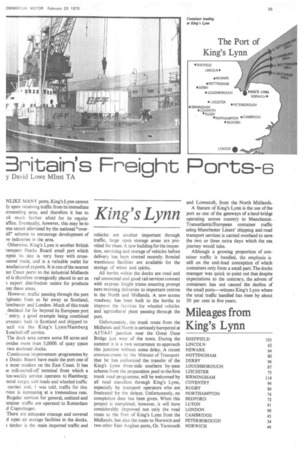bird's eye view
Page 36

Page 37

If you've noticed an error in this article please click here to report it so we can fix it.
by the Hawk • Speak up
Here is a unique situation: Members of the RHA want someone to talk to them. I am not suggesting that the hauliers have been sent to Coventry or that they are feeling lonely but they do think that more use might be made of sub-area meetings. When Eddie Barber, chairman of the association's public relations committee, phoned me this week, he said: "We're looking for speakers at the sub-area meetings and where better to find them than through the pages of your highly esteemed journal?" Flattery will get him everywhere and I hope that anyone who can be of service to the sub-areas will contact Eddie at 1, Woodlands Park, Leigh-on-Sea, SS9 3TX.
• Maiden speech
Michael Heseltine, MP, did not take long to fulfil his promise that he was going out to meet transport operators (CM February 13). Having told colleague lain Sherriff of his intention one Sunday, he met the committee of the London Area Transport Managers' Club at the House of Commons on the following Wednesday. The club chairman, Bill Strath, took the opportunity of inviting Mr. Mulley's shadow to speak to the members at an early date and the invitation was accepted and sealed with a handshake.
The visit of the TMC to Westminster is becoming an annual affair. It was established three years ago by George Miles, last year Frank Hands consolidated the position and this year's chairman has made it a regular event. It has now become the first meeting at which the club chairman presides during his year of office and chairmen can now claim, with some justification, that they make their "maiden speech" in illustrious company.
• Wotchit !
I seem to have been suffering more than my share of near-misses from insecure loads in the past week or so. First encounter was with a large hummock of wet clay in the middle of a busy dual-carriageway at rush-hour, followed by a succession of similar dollops, mixed with brickbats, at irregular intervals. Drivers were having a very concentrated time dodging the deposits and avoiding skids. When I caught up with the culprit it was not, as I'd thought, badly loaded, but simply a rather tired old tipper whose tailgate catch was swinging loose. Every time the driver accelerated, or the vehicle went over g bump, another half-hundredweight of muck went plop on the road.
The second encounter was with a hig,h load of timber on an artic; this had tilted with loadshift on a sharp turn just before I passed by. The enterprising driver had pulled a couple of timbers out of his load and used them rather ingeniously as props, until the rescuers arrived to right the load and vehicle properly. There was a warning to timber carriers, incidentally, in that his load was firmly lashed with stout chains, with all the slack taken up, so it must have taken some force to shift the load—which would have toppled if the chains had not been secure. The recommended steel side stakes would, if fitted, have held the load upright—but would the whole vehicle have gone over, I wonder?
• Crunch !
Incident number three happened in Holland. A steel stockholder's five-tonner, approaching on a heavily cambered dyke road, took a fairly sharp turn and the rear end of a bundle of light steel sections leapt on to the road, striking sparks on the roadway ahead of us. Fortunately the steel held firm on the front bolster behind his cab, and the speed of travel brought the rear end of the steel swinging back alongside the truck before it reached us; but it was a nasty moment.
Returning from Holland, I encountered incident number four on the Victoria Embankment, London, in the dusk. Three vehicles ahead of me was a 24-ton artic carrying two enormous export packing cases, one on top of the other—CKD chassis and parts I would guess. As we approached a railway bridge which crosses over the Embankment, I reckoned the lorry was not going to make it, and hurig back. I was all too right. With an impact like an explosion the front of the top case hit the bridge—it was about four inches too high, I would estimate. The packing case top was sliced off like a boiled egg, and the wood disintegrated into splinters.
We all missed the debris (or it missed .us) and mercifully nothing solid was knockec into the road. The artic, far from being stopped by the collision, went on for a hundred yards before its no doubt shaker driver pulled in to the side.
I wouldn't say I'm demoralized, but I'm giving dodgy-looking loads a wide berth fot a while. As far as one can.
• Rounded money
I suspect transport operators will find decimalization bringing more changes that they presently imagine. Just a few example! of things affected are cash books, account! ledgers, vehicle costing, wages, transpor rates, PAYE records, P.60 certificates o pay and tax—to say nothing of the fare problems for p.s.v. folk.
Any operator who isn't getting read■ now for the February 1971 change-ove may be in for a nasty shock, Some operators, of course, are we] advanced in their plans. For example, I'n most interested to learn from Kirkdale Lcwi Haulage Ltd., of Kirkby, Lanes, that the are going to tackle the difficulty of convert ing creditors' and debtors' balances b: adopting "round shilling" accountinE This, explains m.d. D. F. Rooke, mean that invoice totals are rounded to th nearest shilling according to agreed rule which should provide a fair result.
These rules are: amounts from Id to 5 are rounded down; amounts from 7d to 111 are rounded up; amounts ending in bd an rounded up or down to the nearest even shilling. For instance, 5s 6d becomes 6! but 8s 6d becomes 8s. The system is bein adopted this month, though pence wi continue to be used in rate quotations an invoice extensions. NLIKE MANY ports, King's Lynn cannot ly upon receiving traffic from its immediate trrounding area, and therefore it has to ok much farther afield for its regular affics. Eventually, however, this may be to 'me extent alleviated by the national "overill" scheme to encourage development of nv industries in the area.
Otherwise, King's Lynn is another British ransport Docks Board small port which !spite its size is very busy with crosstannel trade, and is a valuable outlet for anufactured exports. It is one of the nearest ast Coast ports to the industrial Midlands id is therefore strategically placed to act as export distribution centre for products om these areas.
However, traffic passing through the port iginates from as far away as Scotland, [anchester and London. Much of this trade destined for far beyond its European port
entry, a good example being combined irvesters built in Scotland and shipped to .azil via the King's Lynn/Hamburg ll-on/roll-off service.
The dock area covers some 88 acres and ovides more than 5,000ft of quay space two enclosed docks.
Continuous improvement progranunes by e Docks Board have made the port one of e most modern on the East Coast. It has te roll-on/roll-off terminal from which a rice-weekly service operates to Hamburg; neral cargo, unit loads and wheeled traffic carried and, I was told, traffic for this Nice is increasing at a tremendous rate. Regular services for general, unitized and ntainer traffic are operated to Rotterdam d Copenhagen.
There are adequate cranage and covered d open air storage facilities in the docks. s timber is the main imported traffic and
King's Lynn
vehicles are another important through traffic, large open storage areas are provided for these. A new building for the inspection, servicing and storage of vehicles before delivery has been erected recently. Bonded warehouse facilities are available for the storage of wines and spirits.
All berths within the docks are road and rail connected and good rail services connect with express freight trains ensuring prompt next-morning deliveries to important centres in the North and Midlands. A new access roadway has been built to the berths to improve the facilities for wheeled vehicles and agricultural plant passing through the Port.
Unfortunately, the trunk route from the Midlands and North is seriously hampered at A17/A47 junction near the Great Ouse Bridge just west of the town. During the summer it is a rare occurrence to approach this junction without some delay. A recent announcement by the Minister of Transport that he has authorized the transfer of the King's Lynn three-mile southern by-pass scheme from the preparation pool to the firm trunk road programme, will be welcomed by all road travellers through King's Lynn, especially by transport operators who are frustrated by the delays. Unfortunately, no completion date has been given. When this project is completed, however, it will have considerably improved not only the road route to the Port of King's Lynn from the Midlands, but also the route to Norwich and two other East Anglian ports, Gt. Yarmouth
and Lowestoft, from the North Midlands. A feature of King's Lynn is the use of the port as one of the gateways of a land-bridge operating across country to Manchester.
Transatlantic/European container traffic using Manchester Liners' shipping and road transport services is carried overland to save the two or three extra days which the sea journey would take.
Although a growing proportion of container traffic is handled, the emphasis is still on the unit-load conception of which containers only form a small part. The docks manager was quick to point out that despite expectations to the contrary, the advent of containers has not caused the decline of the small ports—witness King's Lynn where the total traffic handled has risen by about 50 per cent in five years.
Mileages from King's Lynn
SHEFFIELD 101 LINCOLN 62 NEWARK 64 NOTTINGHAM 80 DERBY 96 LOUGHBOROUGH 87 LEICESTER 75 BIRMINGHAM 114 COVENTRY 94
RUGBY 84
NORTHAMPTON 74 BEDFORD 72 LUTON 91 LONDON 98 CAMBRIDGE 45 PETERBOROUGH 34
NORWICH 44














































































































































































































